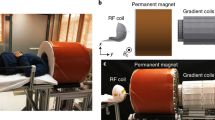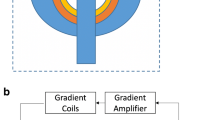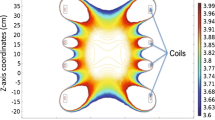Abstract
Objective
In this work, a prototype of an effective electromagnet with a field-of-view (FoV) of 140 mm for neonatal head imaging is presented. The efficient implementation succeeded by exploiting the use of steel plates as a housing system. We achieved a compromise between large sample volumes, high homogeneity, high B0 field, low power consumption, light weight, simple fabrication, and conserved mobility without the necessity of a dedicated water cooling system.
Materials and methods
The entire magnetic resonance imaging (MRI) system (electromagnet, gradient system, transmit/receive coil, control system) is introduced and its unique features discussed. Furthermore, simulations using a numerical optimization algorithm for magnet and gradient system are presented.
Results
Functionality and quality of this low-field scanner operating at 23 mT (generated with 500 W) is illustrated using spin-echo imaging (in-plane resolution 1.6 mm × 1.6 mm, slice thickness 5 mm, and signal-to-noise ratio (SNR) of 23 with a acquisition time of 29 min). B0 field-mapping measurements are presented to characterize the homogeneity of the magnet, and the B0 field limitations of 80 mT of the system are fully discussed.
Conclusion
The cryogen-free system presented here demonstrates that this electromagnet with a ferromagnetic housing can be optimized for MRI with an enhanced and homogeneous magnetic field. It offers an alternative to prepolarized MRI designs in both readout field strength and power use. There are multiple indications for the clinical medical application of such low-field devices.






Similar content being viewed by others
References
Blümich B, Casanova F, Appelt S (2009) NMR at low magnetic fields. Chem Phys Lett 477(4–6):231–240
Stepisnik J, Erzen V, Kos M (1990) NMR imaging in the earth’s magnetic field. Magn Reson Med 15(3):386–391
Mohoric A, Planinsic G, Kos M, Duh A, Stepisnik J (2004) Magnetic resonance imaging system based on earth’s magnetic field. Instrum Sci Technol 32(6):655–667
Mohoric A, Stepisnik J, Kos K, Planinsic G (1999) Self-diffusion imaging by spin echo in earth’s magnetic field. J Magn Reson 136(1):22–26
Appelt S, Kühn H, Häsing W, Blümich B (2006) Chemical analysis by ultrahigh-resolution nuclear magnetic resonance in the earth’s magnetic field. Nat Phys 2:105–109
Appelt S, Häsing FW, Kühn H, Perlo J, Blümich B (2005) Mobile high resolution xenon nuclear magnetic resonance spectroscopy in the earth’s magnetic field. Phys Rev Lett 94(19):197602
Halse ME, Coy A, Dykstra R, Eccles C, Hunter M, Ward R, Callaghan PT (2006) A practical and flexible implementation of 3D MRI in the earth’s magnetic field. J Magn Reson 182(1):75–83
Kegler C, Seton HC, Hutchison JMS (2007) Prepolarized fast spin-echo pulse sequence for low-field MRI Magnetic Resonance in Medicine. Magn Reson Med 57(6):1180–1184
Savukov I, Karaulanov T, Castro A, Volegov P, Matlashov A, Urbatis A, Gomez J, Espy M (2011) Non-cryogenic anatomical imaging in ultra-low field regime: hand MRI demonstration. J Magn Reson 211(2):101–108
Lother S, Hoelscher U, Kampf T, Jakob P, Fidler F (2013) 3D gradient system for two B0 field directions in Earth´s field MRI. Magn Reson Mater Phy 26(6):565–573
Matter NI, Scott GC, Venook RD, Ungersma SE, Grafendorfer T, Macovski A, Conolly SM (2006) Three-dimensional prepolarized magnetic resonance imaging using rapid acquisition with relaxation enhancement. Magn Reson Med 56(5):1085–1095
Savnik A, Malmskov H, Thomsen HS, Bretlau T, Graff LB, Nielsen H, Danneskiold-Samsøe B, Boesen J, Bliddal H (2001) MRI of the arthritic small joints: comparison of extremity MRI (0.2 T) vs high-field MRI (1.5 T). Eur Radiol 11(6):1030–1038
Feynman R, Leighton R, Sands M (2006) The Feynman lectures on physics, vol II. Addison-Wesley, Reading. ISBN 0-8053-9047-2 (Chapter 37: Magnetic Materials)
Wright SM, Brown DG, Porter JR, Spence DC, Esparza E, Cole DC, Huson FR (2002) A desktop magnetic resonance imaging system. Magn Reson Mater Phy 13(3):177–185
Dueck G, Scheuer T (1990) Threshold accepting: a general purpose optimization algorithm appearing superior to simulated annealing. J Comput Phys 90(1):161–175
Kirkpatrick S, Gelatt CD, Vecchi MP (1983) Optimization by simulated annealing. Science 220(4598):671–680
Hidalgo-Tobon SS (2010) Theory of gradient coil design methods for magnetic resonance imaging. Concepts Magn Reson A 36(4):223–242
Turner R (1993) Gradient coil design: a review of methods. Magn Reson Imaging 11(7):903–920
Golay MJE (1958) Field homogenizing coils for nuclear spin resonance instrumentation. Rev Sci Instrum 29(4):313–315
Tanner JE (1965) Pulsed field gradients for NMR spin-echo diffusion measurements. Rev Sci Instrum 36:1086–1087
Carr HY, Purcell EM (1954) Effects of diffusion on free precession in nuclear magnetic resonance experiments. Phys Rev 94(3):630–638
Aksel B, Marinelli L, Collick BD, Von Morze C, Bottomley PA, Hardy CJ (2007) Local planar gradients with order-of-magnitude strength and speed advantage. Magn Reson Med 58(1):134–143
Caparelli EC, Tomasi D, Panepucci H (1999) Shielded biplanar gradient coil design. Magn Reson Imaging 9(5):725–731
Martens MA, Petropoulos LS, Brown RW, Andrews JH, Morich MA, Patrick JL (1991) Insertable biplanar gradient coils for magnetic resonance imaging. Rev Sci Instrum 62(11):2639–2645
Tomasi D, Caparelli EC, Panepucci H, Foerster B (1999) Fast optimization of a biplanar gradient coil set. J Magn Reson 140(2):325–339
Romeo F, Hoult DI (1984) Magnet field profiling—analysis and correcting coil design. Magn Reson Med 1(1):44–65
Sekihara K, Matsui S, Kohno H (1985) NMR imaging for magnets with large nonuniformities. IEEE Trans Med Imaging MI-4(4):193–199
Kartäusch R, Wintzheimer S, Ledwig M, Jakob PM, Fidler F (2011) Compact magnet design with significantly reduced eddy currents based on ferrite material. In: International conference on magnetic resonance microscopy (ICMRM), Beijing, China, p 202
Mispelter J, Lupu M, Briguet A (2006) NMR Probeheads for Biophysical and Biomedical Experiments. Imperial College Press, London
Grafendorfer T, Conolly S, Sullivan C, Macovski A, Scott G (2005) Can Litz coils benefit SNR in remotely polarized MRI? In: Proceedings of the 13th annual meeting of ISMRM, Miami Beach, FL, USA, p 923
do Nascimento GC, de Souza RE, Engelsberg M (1989) A simple, ultralow magnetic field NMR imaging system. J Phys E Sci Instrum 22(9):774–779
Savukov I, Karaulanov T, Wurden C, Schultz L (2013) Non-cryogenic ultra-low field MRI of wrist–forearm area. J Magn Reson 233:103–106
Savukov I, Karaulanov T, Castro A, Volegov P, Matlashov A, Urbatis A, Gomez J, Espy M (2011) Non-cryogenic anatomical imaging in ultra-low field regime: hand MRI demonstration. J Magn Reson 211:101–108
LaPierre C, Sarracanie M, Waddington DEJ, Rosen MS (2015) A single channel spiral volume coil for in vivo imaging of the whole human brain at 6.5 mT. In: Proceedings of the 23rd annual meeting of ISMRM, Toronto, ON, Canada, p 1793
Warf BC (2005) Hydrocephalus in Uganda: the predominance of infectious origin and primary management with endoscopic third ventriculostomy. J Neurosurg 102(1 Suppl):1–15
Mandell JG, Kulkarni AV, Warf BC, Schiff SJ (2015) Volumetric brain analysis in neurosurgery: part 2. Brain and CSF volumes discriminate neurocognitive outcomes in hydrocephalus. J Neurosurg Pediatr 15(2):125–132
Savukov I, Karaulanov T (2013) Magnetic-resonance imaging of the human brain with an atomic magnetometer. Appl Phys Lett 103(4):43703
Acknowledgments
We thank Toni Drießle for helpful discussions and permanently valuable engineering inputs.
Author information
Authors and Affiliations
Corresponding author
Ethics declarations
Conflict of interest
The authors declare that they have no conflict of interest.
Ethical standards
This article does not contain any studies with human or animal subjects.
Rights and permissions
About this article
Cite this article
Lother, S., Schiff, S.J., Neuberger, T. et al. Design of a mobile, homogeneous, and efficient electromagnet with a large field of view for neonatal low-field MRI. Magn Reson Mater Phy 29, 691–698 (2016). https://doi.org/10.1007/s10334-016-0525-8
Received:
Revised:
Accepted:
Published:
Issue Date:
DOI: https://doi.org/10.1007/s10334-016-0525-8




